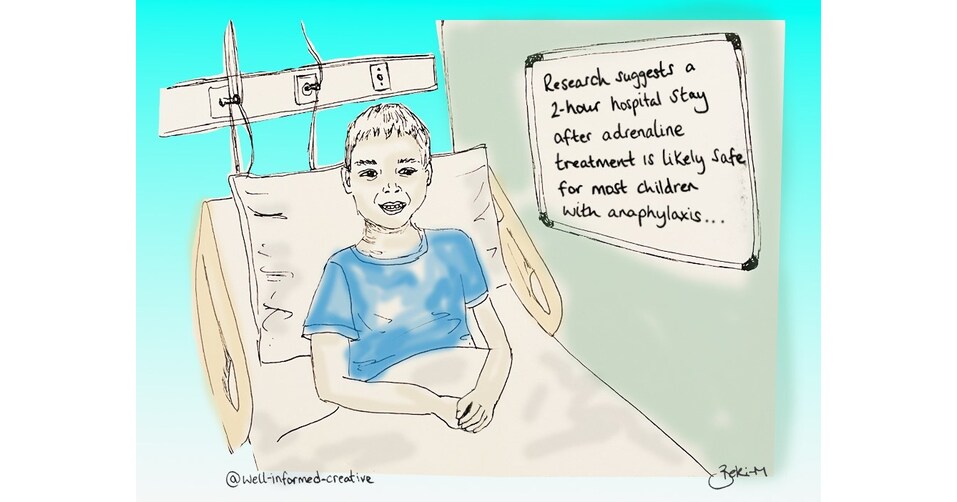While many children experiencing anaphylaxis stay for long hours, even overnight, after receiving a dose of epinephrine, 95% could be safely discharged within 2 hours and 98% within 4 hours, study led by experts at Cincinnati Children’s reports
CINCINNATI, June 10, 2025 /PRNewswire/ — Be it peanuts or other triggers, many families live with the day-to-day risk that their child might experience a sudden and scary allergic reaction. In fact, pediatric emergency department visits in the United States to treat acute allergic reactions more than tripled from 2008 to 2016.
Study finds many children treated with epinephrine injections after acute allergic reactions spend too much time in hospitals for observation. Illustration courtesy of Rebecca McGee.
But once they arrive at the hospital, many children are staying much longer than necessary according to a study involving more than 5,000 children conducted at 31 hospitals in the US and Canada. Findings were published June 10, 2025, in Lancet: Child and Adolescent Health.
“Years ago, we used to admit virtually all kids with anaphylaxis to the hospital. We have stopped doing that, but most hospitals still routinely observe kids for over four hours, some even longer. And almost all hospitals admit kids if they have any signs of cardiovascular involvement,” says the study’s lead author Tim Dribin, MD, an emergency medicine physician at Cincinnati Children’s.
“Our study suggests that 95% of patients could have been safely discharged two hours after receiving their first epinephrine dose and that 98% could have been safely discharged four hours after the first epinephrine dose.”
Why so much observation time?
The overwhelming majority of children visiting emergency departments for acute allergic reactions can be routinely treated and promptly sent home. In an age where many people with allergies—even young children—carry their own epinephrine injector pens, many situations require no hospital visit at all.
However, about 5% of children experience a “biphasic reaction,” which means their symptoms can return even though they received an epinephrine injection. In the absence of clear standards, many clinicians choose to keep patients in hospital for long periods of observation just in case.
“One concern about biphasic reactions is that the time it takes for symptoms to re-emerge can be highly variable,” Dribin says. “This study was designed to take a closer look at this population and determine if children at very low risk can be better identified and discharged safely.”
Clearing the backup
The research team gathered data from 5,641 emergency visits where anaphylaxis was treated with an epinephrine injection. About 90% of the children studied experienced allergic reactions to foods, including peanuts, eggs, milk, shellfish, sesame, gluten and soy. In some cases, the exact food trigger was not known. About 6% involved medication reactions and 3% involved insect stings.
While nearly 17% of children were admitted for overnight observation, and others stayed in emergency departments well beyond 4 hours, the need for second doses of epinephrine to cope with biphasic reactions tended to show up quickly. The study found that 4.7% of patients received a second dose within two hours of their initial injection and that 1.9% received a second dose after four hours.
Some children clearly needed hospital-level care from the moment they arrived at the hospital. About 1% of all the children studied needed high-acuity services such as ventilators to support breathing. But among the rest of those admitted to hospital beds, most never needed a second epinephrine shot much less intensive care.
“We stratified the patients by severity groups and found that patients with no cardiovascular involvement were at low risk of receiving repeat epinephrine beyond 2 hours after the initial epinephrine dose,” Dribin says. “Meanwhile even the patients with cardiovascular involvement were at low risk of receiving repeat epinephrine beyond 4 hours.”
Potential time and resource savings
Overall, children with severe allergic reactions represent a modest flow of demand for emergency care. However, having beds occupied for any unnecessary observation periods makes it harder to serve other patients in need.
“Pediatric emergency departments can get crowded quite quickly, especially during winter infection season. We need to ensure efficient throughput to allow us to provide access to as many patients as we can,” says David Schnadower, MD, MPH, director of the Division of Emergency Medicine at Cincinnati Children’s. “An important value of this study is that it was large enough that the results can give clinicians confidence that discharging patients showing no concerning symptoms in less than two hours is going to be safe for most children.”
The study did not attempt to calculate the potential cost savings that could be achieved because hospital prices and care practices can vary so widely. However, the savings from reducing unnecessary hospital admissions could be substantial, the co-authors say.
“I think the bigger impact would be for the patients and families…parents being able to go back to work quicker, children missing less school,” Dribin says. “This data allows clinicians to make decisions about observation based on their risk tolerance and that of the patient and the family Some families might feel risk-averse and want to stay a little longer. Others might have another auto injector, and they feel comfortable managing at home. Having that choice is really empowering.”
Co-author Hugh Sampson, MD, an allergist at the Icahn School of Medicine at Mount Sinai in New York City, agrees.
“We also have seen patients and their families avoid or delay going to the emergency department because they didn’t want to sit there for hours of observation,” Sampson says. “Such delays can prove dangerous. This study’s findings support discharging patients more expeditiously, which will likely reduce patient reluctance to seek necessary help.”
Funding sources for this study included the National Center for Advancing Translational Sciences and The National Institute of Allergy and Infectious Diseases.
SOURCE Cincinnati Children’s Hospital Medical Center



